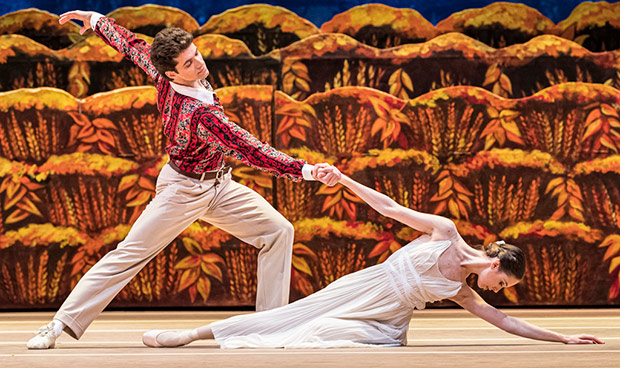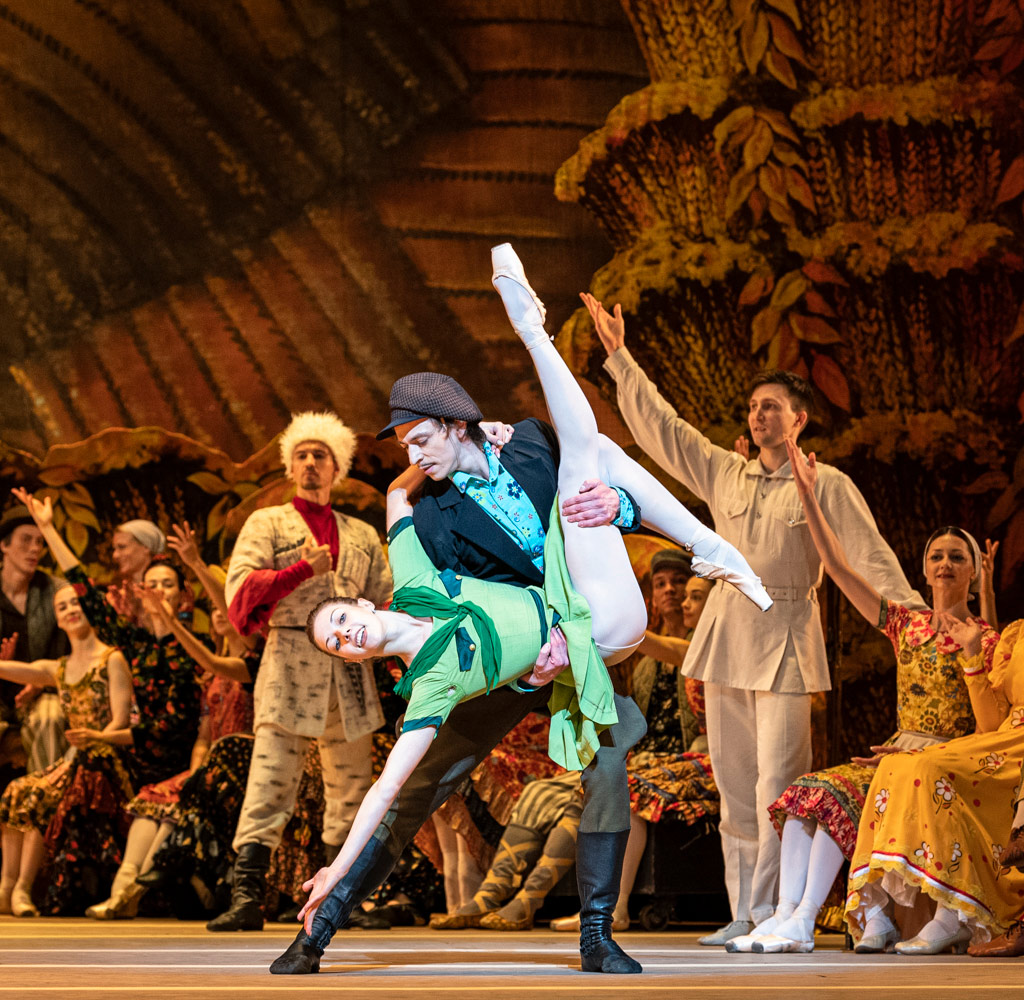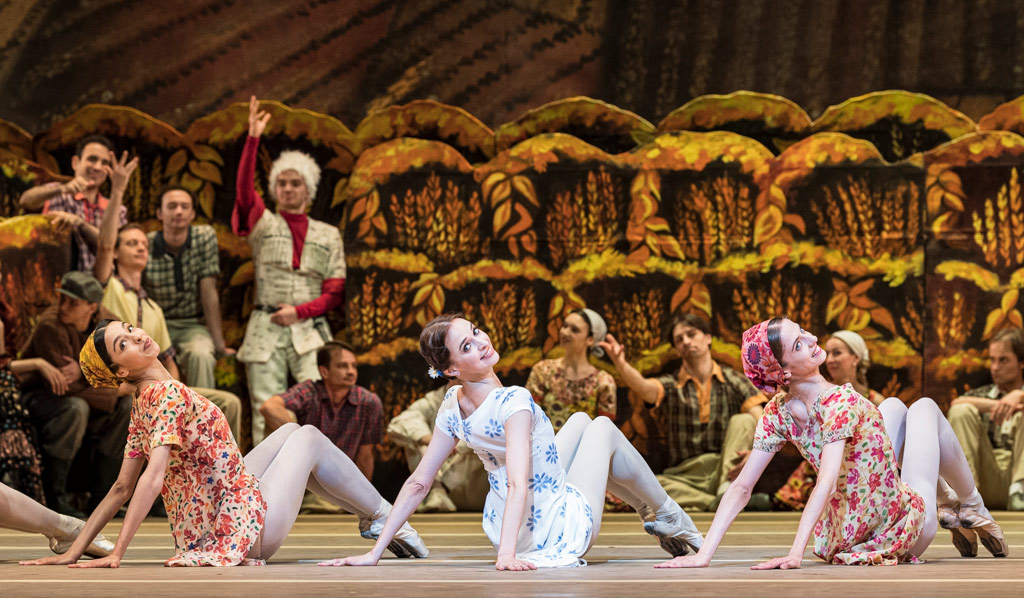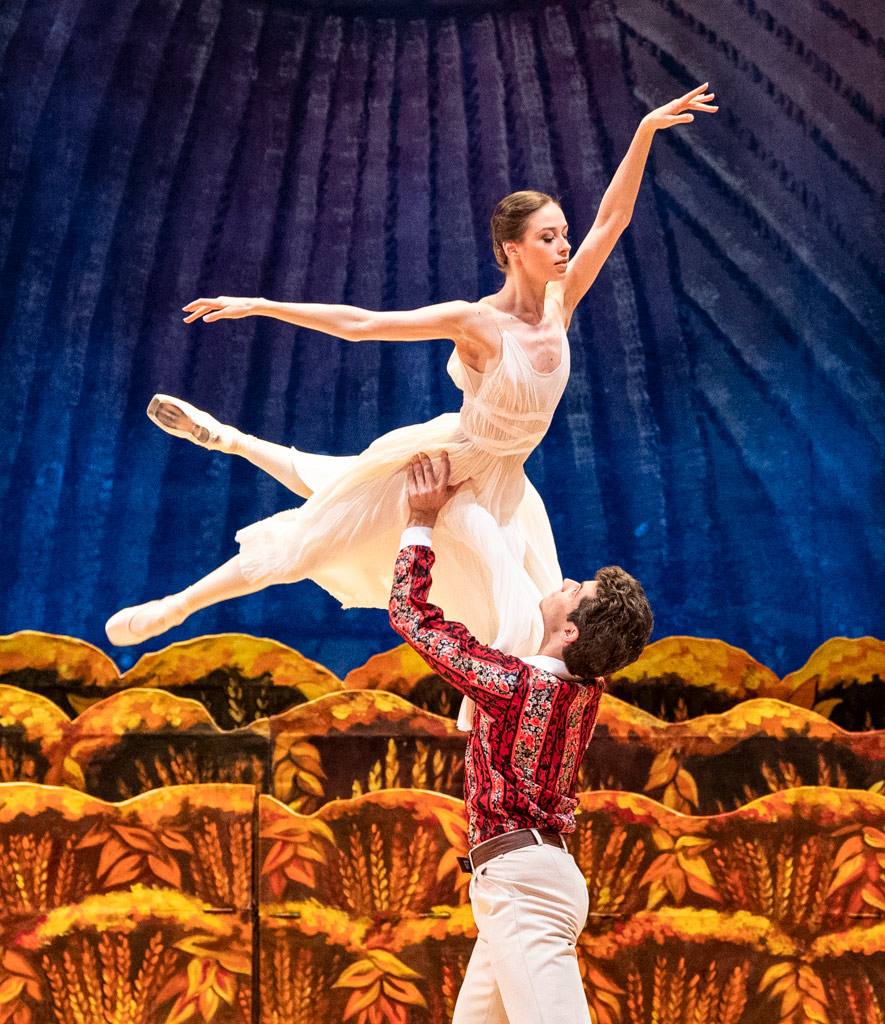
© Foteini Christofilopoulou. (Click image for larger version)
Bolshoi Ballet
The Bright Stream
★★★★★
London, Royal Opera House
7 August 2019
Gallery of pictures by Foteini Christofilopoulou
www.bolshoi.ru
www.roh.org.uk
‘To reflect socialist reality in a ballet is a serious undertaking’, wrote Dmitri Shostakovich in a programme note for the 1935 Bolshoi premiere of The Bright Stream. Although he may have meant it at the time, his ballet score sounds far from serious. Interpreted by the Bolshoi Ballet’s conductor, Pavel Sorokin, for choreography by Alexei Ratmansky, it is slily satirical and hugely entertaining, appropriating popular tunes and excerpts from his own works.
Stalin didn’t find the music or the original choreography by Fyodor Lopukhov funny at all. Although the action takes place on a collective farm, named The Bright Stream, the performers are hardly convincing as agricultural workers. An article in Pravda accused the production of ‘Ballet Fraud’, and the perpetrators were vilified. The banned ballet was lost until Ratmansky recreated it in 2003, before he became artistic director of the Bolshoi Ballet for four years.

© Foteini Christofilopoulou. (Click image for larger version)
His version of The Bright Stream starts with a black-and-white front cloth displaying the Communist hammer and sickle symbol, surrounded by Soviet slogans and headlines from Pravda articles attacking Shostakovich. All solemnity vanishes when the cloth lifts to reveal a brilliantly coloured decor of fertile farmland, designed by Boris Messerer in Russian folk-art style. Rows of wheat sheaves provide handy hiding places once comical conspiracies get under way.
The scenario, based on the 1935 one, involves three couples: young husband and wife Pyotr and Zina, members of the collective farm; a pair of professional ballet dancers (unnamed) visiting from Moscow; an elderly Dacha dweller and his pretentious wife. The Collective is holding a harvest festival, so workers come in from surrounding areas to celebrate, providing Ratmansky with plenty of opportunities for inventive choreography to music seemingly made for it.
It turns out that Zina (Daria Khokhlova) and the visiting ballerina (Ekaterina Krysanova) were at ballet school together, so they display their academic training by dancing alongside each other. They are never quite in unison, which makes sense: Zina is but a ‘morale officer’ for the Collective, a country mouse compared with her sophisticated friend and rival. Khokhlova is fresh and vital as feisty Zina; Krysanova is a firecracker, with a rocket-like elevation in her split jetés, soaring round the stage.

© Foteini Christofilopoulou. (Click image for larger version)
The female farm hands in floral frocks and headscarves dance as though they, too, were ballet school students before populating the Collective in the steppes. Their male equivalents perform a variety of folk dances, wearing different kinds of hats and boots (the Cossacks still sport their fur hats at harvest time). There’s cartoon choreography for the doddery dacha dweller and his plump, over-eager wife, and exuberant numbers for a lascicious accordion player (Denis Savin) and a naughty schoolgirl (Yulia Skvortsova), both thoroughly enjoying themselves.
The basic plot involves would-be faithless partners being taught a lesson. Zina’s agricultural student husband (Igor Tsvirko) is smitten with the ballerina, who wants none of him. She lends her costume to Zina, who, thus disguised, dances a romantic pas de deux with her besotted husband. The duet has all the hallmarks of an acrobatic Soviet pas de deux, all the funnier because Tsvirko is cast as a heroic Spartacus in Yuri Grigorovich’s ballet of the same name. As Pyotr, trying to be impressive, he is all brawn and no brain. He doesn’t deserve Zina’s forgiveness at the end.

© Foteini Christofilopoulou. (Click image for larger version)
The ballerina is meanwhile passing herself off as her male partner, Ruslan Skvortsov. Only now can you appreciate just how tiny Krysanova is. He has somehow acquired a large enough costume and pair of point shoes to appear as a sylph in order to bemuse the silly old dacha dweller (Yuri Ostrovsky). Skvortsov, who seemed a bit of a nonentity as the visiting male dancer, outdoes the Trocks as a hilarious ballerina impersonator. He and Ratmansky know that the comedy depends on a muscular man striving to be ethereal, in all seriousness.
Adopting a pained, spiritual expression, Skvortsov entices the old boy to pursue him, using many of the same tricks as Bournonville’s Sylphide. Ratmansky, who danced with the Royal Danish Ballet, knows La Sylphide well, as do audience members, laughing in recognition at the references as well as at the performers’ pratfalls. Skvortsov parodies the Sylph’s winning ways but executes the pointe work admirably, with multiple pirouettes and dainty hops beneath his swirling skirts.

© Foteini Christofilopoulou. (Click image for larger version)
A wildly surreal comic turn involves a dog riding a bicycle, both cunningly choreographed. He’s actually a tractor driver in disguise, disrupting sexual assignations. Almost as bizarre is a parade of vegetables, each one larger than the last, as the harvest festival reaches its climax. There’s a crazy skipping round-up of all the participants, to music that evokes hysterical communal excitement. Why didn’t Stalin and his stooges laugh and cheer instead of purporting to take offence?
It’s a shame that The Bright Stream was scheduled for only two performances during the Bolshoi’s Opera House season. But Lilian Hochhauser is wisely wary of summer audiences’ conservatism: while Swan Lake always sells out, lesser known works displaying the range of Russian dancers’ talents don’t do so well at the box office. The Bolshoi Ballet and Opera companies do, however, offer cinema relays and repeats of their productions, as well as DVDs, so there is the chance to find out more about them. Meanwhile, the live season continues at the Opera House until 17 August, with performances of Spartacus, Swan Lake and Don Quixote.

















Wonderful review! I’ll never forget my first experience of seeing this ballet performed by the Bolshoi here in New York in 2005. I couldn’t believe how charming, musical, detailed, funny, delicate, over-the-top, and human it was. It completely turned a new page for me in my appreciation of ballet.
Several of the Soviet slogans on the front cloth are women’s lib exhortations by Stalin himself – “Women out of the shadows” and “Female force” (or similar). I don’t know if that was in Boris Messerer’s original design or Ratmansky’s ironic update along with the condemnations of Shostakovich. But the girl-power slogans are a good clue to the ballet’s complicated subplots as the women mostly win their battles with the menfolk.
Love that detail, Ismene!
I believe this was one of the productions in a Bolshoi in Cinema versions – probably not so intriguing as live, but still it was quite a treat.